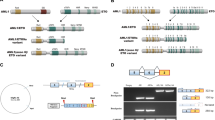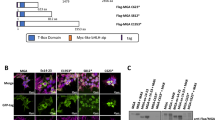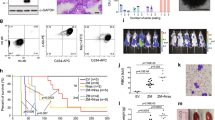Abstract
The t(8;21) is one of the most frequent chromosomal translocations associated with acute leukemia. This translocation creates a fusion protein consisting of the acute myeloid leukemia-1 transcription factor and the eight-twenty-one corepressor (AML1–ETO), which represses transcription through AML1 (RUNX1) DNA binding sites and immortalizes hematopoietic progenitor cells. We have identified the p14ARF tumor suppressor, a mediator of the p53 oncogene checkpoint, as a direct transcriptional target of AML1–ETO. AML1–ETO repressed the p14ARF promoter and reduced endogenous levels of p14ARF expression in multiple cell types. In contrast, AML1 stimulated p14ARF expression and induced phenotypes consistent with cellular senescence. Chromatin immunoprecipitation assays demonstrated that AML1–ETO was specifically bound to the p14ARF promoter. In acute myeloid leukemia samples containing the t(8;21), levels of p14ARF mRNA were markedly lower when compared with other acute myeloid leukemias lacking this translocation. Repression of p14ARF may explain why p53 is not mutated in t(8;21)-containing leukemias and suggests that p14ARF is an important tumor suppressor in a large number of human leukemias.
This is a preview of subscription content, access via your institution
Access options
Subscribe to this journal
Receive 12 print issues and online access
$209.00 per year
only $17.42 per issue
Buy this article
- Purchase on Springer Link
- Instant access to full article PDF
Prices may be subject to local taxes which are calculated during checkout






Similar content being viewed by others
References
Rowley, J.D. The role of chromosome translocations in leukemogenesis. Semin. Hematol. 36, 59–72 (1999).
Rubnitz, J.E., Pui, C.H. & Downing, J.R. The role of TEL fusion genes in pediatric leukemias. Leukemia 13, 6–13 (1999).
Osato, M. et al. Biallelic and heterozygous point mutations in the runt domain of the AML1/PEBP2alphaB gene associated with myeloblastic leukemias. Blood 93, 1817–1824 (1999).
Song, W.J. et al. Haploinsufficiency of CBFA2 causes familial thrombocytopenia with propensity to develop acute myelogenous leukaemia. Nature Genet. 23, 166–175 (1999).
Melnikova, I.N., Crute, B.E., Wang, S. & Speck, N.A. Sequence specificity of the core-binding factor. J. Virol. 67, 2408–2411 (1993).
Meyers, S., Downing, J.R. & Hiebert, S.W. Identification of AML-1 and the (8;21) translocation protein (AML-1/ETO) as sequence-specific DNA-binding proteins: The runt homology domain is required for DNA binding and protein–protein interactions. Mol. Cell. Biol. 13, 6336–6345 (1993).
Amann, J.M. et al. ETO, a target of t(8;21) in acute leukemia, makes distinct contacts with multiple histone deacetylases and binds mSin3A through its oligomerization domain. Mol. Cell. Biol. 21, 6470–6483 (2001).
Licht, J.D. AML1 and the AML1-ETO fusion protein in the pathogenesis of t(8;21) AML. Oncogene 20, 5660–5679 (2001).
Rhoades, K.L. et al. Analysis of the role of AML1–ETO in leukemogenesis, using an inducible transgenic mouse model. Blood 96, 2108–2115 (2000).
Okuda, T. et al. Expression of a knocked-in AML1-ETO leukemia gene inhibits the establishment of normal definitive hematopoiesis and directly generates dysplastic hematopoietic progenitors. Blood 91, 3134–3143 (1998).
Mulloy, J.C. et al. The AML1-ETO fusion protein promotes the expansion of human hematopoietic stem cells. Blood 99, 15–23 (2002).
Bates, S. et al. p14ARF links the tumour suppressors RB and p53. Nature 395, 124–125 (1998).
Cong, F., Zou, X., Hinrichs, K., Calame, K. & Goff, S.P. Inhibition of v-Abl transformation by p53 and p19ARF. Oncogene 18, 7731–7739 (1999).
de Stanchina, E. et al. E1A signaling to p53 involves the p19(ARF) tumor suppressor. Genes Dev. 12, 2434–42 (1998).
Palmero, I., Pantoja, C. & Serrano, M. p19ARF links the tumour suppressor p53 to Ras. Nature 395, 125–126 (1998).
Zindy, F. et al. Myc signaling via the ARF tumor suppressor regulates p53-dependent apoptosis and immortalization. Genes Dev. 12, 2424–2433 (1998).
Pomerantz, J. et al. The Ink4a tumor suppressor gene product, p19Arf, interacts with MDM2 and neutralizes MDM2's inhibition of p53. Cell 92, 713–723 (1998).
Zhang, Y., Xiong, Y. & Yarbrough, W.G. ARF promotes MDM2 degradation and stabilizes p53: ARF-INK4a locus deletion impairs both the Rb and p53 tumor suppression pathways. Cell 92, 725–734 (1998).
Harvey, D.M. & Levine, A.J. p53 alteration is a common event in the spontaneous immortalization of primary BALB/c murine embryo fibroblasts. Genes Dev. 5, 2375–2385 (1991).
Kamijo, T. et al. Tumor suppression at the mouse INK4a locus mediated by the alternative reading frame product p19ARF. Cell 91, 649–659 (1997).
Sherr, C.J. Cancer cell cycles. Science 274, 1672–1627 (1996).
Sharpless, N.E. & DePinho, R.A. The INK4A/ARF locus and its two gene products. Curr. Opin. Genet. Dev. 9, 22–30 (1999).
Sharpless, N.E. et al. Loss of p16Ink4a with retention of p19Arf predisposes mice to tumorigenesis. Nature 413, 86–91 (2001).
Krimpenfort, P., Quon, K.C., Mooi, W.J., Loonstra, A. & Berns, A. Loss of p16Ink4a confers susceptibility to metastatic melanoma in mice. Nature 413, 83–86 (2001).
Dimri, G.P., Itahana, K., Acosta, M. & Campisi, J. Regulation of a senescence checkpoint response by the E2F1 transcription factor and p14(ARF) tumor suppressor. Mol. Cell. Biol. 20, 273–285 (2000).
Zhang, Y. & Xiong, Y. Mutations in human ARF exon 2 disrupt its nucleolar localization and impair its ability to block nuclear export of MDM2 and p53. Mol. Cell. 3, 579–591 (1999).
Imamura, J., Miyoshi, I. & Koeffler, P.H. p53 in hematologic malignancies. Blood 84, 2412–2421 (1994).
Zhou, M., Yeager, A.M., Smith, S.D. & Findley, H.W. Overexpression of the MDM2 gene by childhood acute lymphoblastic leukemia cells expressing the wild-type p53 gene. Blood 85, 1608–1614 (1995).
Banker, D.E. et al. The t(8;21) translocation is not consistently associated with high Bcl- 2 expression in de novo acute myeloid leukemias of adults. Clin. Cancer Res. 4, 3051–3062 (1998).
Quesnel, B., Preudhomme, C. & Fenaux, P. p16ink4a gene and hematological malignancies. Leuk. Lymphoma 22, 11–24 (1996).
Robertson, K.D. & Jones, P.A. The human ARF cell cycle regulatory gene promoter is a CpG island which can be silenced by DNA methylation and down-regulated by wild-type p53. Mol. Cell Biol. 18, 6457–6473 (1998).
Lenny, N., Meyers, S. & Hiebert, S.W. Functional domains of the t(8;21) fusion protein, AML-1/ETO. Oncogene 11, 1761–1769 (1995).
Stott, F.J. et al. The alternative product from the human CDKN2A locus, p14(ARF), participates in a regulatory feedback loop with p53 and MDM2. EMBO J. 17, 5001–5014 (1998).
Dimri, G.P. et al. A biomarker that identifies senescent human cells in culture and in aging skin in vivo. Proc. Natl. Acad. Sci. USA 92, 9363–9367 (1995).
Ruas, M. & Peters, G. The p16INK4a/CDKN2A tumor suppressor and its relatives. Biochim. Biophys. Acta 1378, F115–177 (1998).
Taniguchi, T. et al. Expression of p16INK4A and p14ARF in hematological malignancies. Leukemia 13, 1760–1769 (1999).
Simmons, D. & Seed, B. Isolation of a cDNA encoding CD33, a differentiation antigen of myeloid progenitor cells. J. Immunol. 141, 2797–2800 (1988).
Eischen, C.M., Weber, J.D., Roussel, M.F., Sherr, C.J. & Cleveland, J.L. Disruption of the ARF-Mdm2-p53 tumor suppressor pathway in Myc-induced lymphomagenesis. Genes Dev. 13, 2658–2669 (1999).
Eliyahu, D., Raz, A., Gruss, P., Givol, D. & Oren, M. Participation of p53 cellular tumour antigen in transformation of normal embryonic cells. Nature 312, 646–649 (1984).
Weber, J.D. et al. p53-independent functions of the p19(ARF) tumor suppressor. Genes Dev. 14, 2358–2365 (2000).
Jacobs, J.J., Kieboom, K., Marino, S., DePinho, R.A. & van Lohuizen, M. The oncogene and Polycomb-group gene bmi-1 regulates cell proliferation and senescence through the ink4a locus. Nature 397, 164–168 (1999).
Jacobs, J.J. et al. Senescence bypass screen identifies TBX2, which represses Cdkn2a (p19(ARF)) and is amplified in a subset of human breast cancers. Nature Genet. 26, 291–299 (2000).
Serrano, M., Lin, A.W., McCurrach, M.E., Beach, D. & Lowe, S.W. Oncogenic ras provokes premature cell senescence associated with accumulation of p53 and p16INK4a. Cell 88, 593–602 (1997).
Shang, Y., Hu, X., DiRenzo, J., Lazar, M.A. & Brown, M. Cofactor dynamics and sufficiency in estrogen receptor-regulated transcription. Cell 103, 843–852 (2000).
Acknowledgements
We thank P. Jones and K. Robertson (NIH) for providing the p14ARF promoter plasmid; S. Nimer for the Kasumi-1 cells; A. Melnick for SKNO-1 cells; K.S. Luce, Y. Hou and D. King for technical assistance; and the Vanderbilt-Ingram Cancer Center sequencing facility. This work was supported by NIH grants RO1-AG13726, RO1-CA64140 and RO1-87549, a Center grant from the National Cancer Institute (CA68485), and the Vanderbilt-Ingram Cancer Center. The laboratories of C.M.-T. and H. S. are supported by grants from the IZKF at the University of Munster, the Deutsche Forschungsgemeinschaft and the José-Carreras Leukemia Foundation. J.N. was a Leukemia Society of America Special Fellow (Grant No. 3827-99).
Author information
Authors and Affiliations
Corresponding author
Ethics declarations
Competing interests
The authors declare no competing financial interests.
Rights and permissions
About this article
Cite this article
Linggi, B., Müller-Tidow, C., van de Locht, L. et al. The t(8;21) fusion protein, AML1–ETO, specifically represses the transcription of the p14ARF tumor suppressor in acute myeloid leukemia. Nat Med 8, 743–750 (2002). https://doi.org/10.1038/nm726
Received:
Accepted:
Published:
Issue Date:
DOI: https://doi.org/10.1038/nm726
This article is cited by
-
RUNX3 inactivates oncogenic MYC through disruption of MYC/MAX complex and subsequent recruitment of GSK3β-FBXW7 cascade
Communications Biology (2023)
-
AML1/ETO and its function as a regulator of gene transcription via epigenetic mechanisms
Oncogene (2021)
-
RUNX3 regulates cell cycle-dependent chromatin dynamics by functioning as a pioneer factor of the restriction-point
Nature Communications (2019)
-
Constitutional mutation in CDKN2A is associated with long term survivorship in multiple myeloma: a case report
BMC Cancer (2017)



